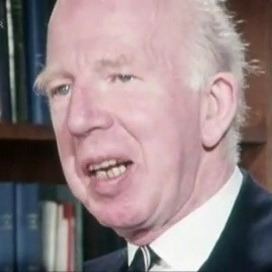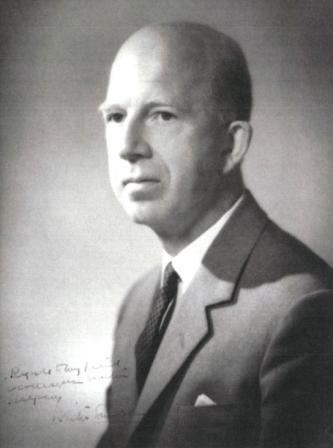Name Keith Simpson Role Pathologist | Died July 21, 1985 | |
 | ||
Books Forty Years of Murder | ||
Molly lefebure 1919 2013 talks about her work with keith simpson may 2012
Cedric Keith Simpson, CBE, FRCP, FRCPath, (20 July 1907 – 21 July 1985) was an English forensic pathologist. He was Professor of Forensic Medicine in the University of London at Guy's Hospital, Lecturer in Forensic Medicine at the University of Oxford and a founder member and President of the Association of Forensic Medicine. Professor Simpson became renowned for his post-mortems on high-profile murder cases, including the 1949 Acid Bath Murders committed by John George Haigh and the murder of gangster George Cornell, who was shot dead by Ronnie Kray in 1966.
Contents
- Molly lefebure 1919 2013 talks about her work with keith simpson may 2012
- Career
- Famous cases
- Awards and affiliations
- Family life
- Teaching
- Death
- References

He pioneered forensic dentistry, and was prominent in alerting physicians and others to the reality of the battered baby syndrome. Professor Simpson wrote a standard textbook on his subject and edited Taylor's Medical Jurisprudence, a basic work of reference of the British medical profession. Forty Years of Murder was Simpson's autobiography and became an international best-seller in the late 1970s. He was London’s first forensic pathologist to be recognised by the Home Office, and in 1975 his long public service was recognised with the award of a CBE. Professor Keith Simpson had by then gained the reputation of having performed more autopsies than any other pathologist in the world.
Career
Keith Simpson was born in 1907 in Brighton, Sussex where his father was a general practitioner. In August 1924, aged 17, Simpson enrolled at Guy’s Hospital Medical School. By the age of 25 he was a teacher in the Pathology Department. In 1934 Dr Simpson was made Supervisor of Medico-legal Post-Mortems and had his first case with Scotland Yard. In 1937 he was appointed Medico-legal advisor to Surrey Constabulary.
In 1947 the student textbook Forensic Medicine, which Simpson wrote during the war, was published. Following the death of Bernard Spilsbury in the same year, Simpson became one of the leading forensic pathologists in Britain, with a string of important cases. In 1950, along with Francis Camps, Donald Teare and Professor Sydney Smith, Simpson formed the Association of Forensic Medicine.
In 1963 he was elected to the Royal College of Pathologists. Two years later, Simpson addressed the annual meeting of the NSPCC and spoke on the topic of 'battered babies'.
In addition to his scientific publications, popular works such as his 1978 autobiography Forty Years of Murder made his name familiar to the public.
He practiced medicine from 146 Harley Street and Guy's Hospital.
Famous cases
Awards and affiliations
Professor Keith Simpson was a member of many medical organisations, one of the founders of the British Association in Forensic Medicine, a former president of the Medico-Legal Society, and a member of the council of the Royal College of Pathologists and the Medical Protection Society. He was the only London forensic pathologist to be recognised as a Home Office pathologist and was a member of the Home Office Scientific Advisory Committee. A fellow of the Royal College of Physicians and the Royal College of Pathologists, Professor Simpson received honorary degrees from the universities of Oxford, Edinburgh and Ghent. His long public service was recognised with the award of a CBE in 1975. In June 2012, Simpson was honoured with the installation of a Westminster City Council Green Plaque at his former residence at 1 Weymouth Street, Marylebone.
Family life
Cedric Keith Simpson was born in 1907 near Brighton, Sussex, where his father was a GP. He attended Brighton, Hove and Sussex Grammar School and at 17 he enrolled at Guy's Hospital Medical School where he became a top student. In 1932 Keith Simpson married Mary Buchanan, with whom he had three children (their only son later became a doctor). They were together until Mary's death from multiple sclerosis in 1955. Dr Simpson married his secretary, Jean Scott-Dunn, in March 1956 and they lived in Marylebone. His second wife died of cancer in 1976. Dr Janet Thurston, widow of fellow coroner Dr Gavin Thurston, became his third wife in 1982.
Teaching
He was a talented teacher, through both the spoken and the printed word. The first edition of his book Simpson’s Forensic Medicine was published in 1947, and in 1959 was awarded the Swiney Prize of the Royal Society of Arts as the best work on medical jurisprudence of the preceding ten years.
To one of his nurses, at a postmortem of a woman who had died as a result of a botched illegal abortion, he had said that "he saw at least two young girls a week who died as a result of septic abortions", and that he was adamant that abortion should be legalized.
Death
He died 21 July 1985, the day after his 78th birthday.
